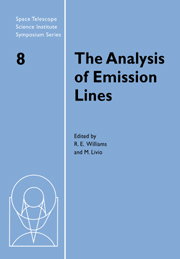Book contents
- Frontmatter
- Contents
- Participants
- Preface
- Emission Lines: Past and Future
- Atomic Data for the Analysis of Emission Lines
- Radiative Transfer
- Emission Lines from Winds
- Photoionizing Shocks
- The Lexington Benchmarks for Numerical Simulations of Nebulae
- Emission Line Diagnostics
- Ultraviolet Spectroscopy
- Infrared Emission Lines as Probes of Gaseous Nebulae
- Molecular Emission Line Diagnostics in Astrophysical Environments
- Abundance Determinations
- Astrophysical Gamma Ray Emission Lines
- Summary Remarks
The Lexington Benchmarks for Numerical Simulations of Nebulae
Published online by Cambridge University Press: 23 November 2009
- Frontmatter
- Contents
- Participants
- Preface
- Emission Lines: Past and Future
- Atomic Data for the Analysis of Emission Lines
- Radiative Transfer
- Emission Lines from Winds
- Photoionizing Shocks
- The Lexington Benchmarks for Numerical Simulations of Nebulae
- Emission Line Diagnostics
- Ultraviolet Spectroscopy
- Infrared Emission Lines as Probes of Gaseous Nebulae
- Molecular Emission Line Diagnostics in Astrophysical Environments
- Abundance Determinations
- Astrophysical Gamma Ray Emission Lines
- Summary Remarks
Summary
We present the results of a meeting on numerical simulations of ionized nebulae held at the University of Kentucky in conjunction with the celebration of the 70th birthdays of Profs. Donald Osterbrock and Michael Seaton.
Introduction
Numerical simulations of emission line regions, whether photo or shock ionized, are a vital tool in the analysis and interpretation of spectroscopic observations. Models can determine characteristics of the central source of ionizing radiation, the composition and conditions within the emitting gas, or, for shocks, the shock velocity. Osterbrock (1989) and Draine & McKee (1993) review the basic physical processes in these environments.
Although numerical simulations are a powerful tool, this capability is somewhat mitigated by the complexity of the calculations. There will always be underlying questions regarding the astronomical environment (i.e., the shape of the ionizing continuum, inhomogeneities, or the composition of the gas) and uncertainties introduced by the evolving atomic/molecular data base. On top of this, however, the numerical approximations, assumptions, and the complexity of the simulations themselves introduce an uncertainty that cannot be judged from a single calculation.
With these questions in mind Daniel Péquignot held a meeting on model nebulae in Meudon, France, in 1985. This provided a forum where investigators could carefully compare model predictions and identify methods, assumptions, or atomic data which led to significant differences in results.
Information
- Type
- Chapter
- Information
- The Analysis of Emission Lines , pp. 83 - 96Publisher: Cambridge University PressPrint publication year: 1995
Accessibility standard: Unknown
Why this information is here
This section outlines the accessibility features of this content - including support for screen readers, full keyboard navigation and high-contrast display options. This may not be relevant for you.Accessibility Information
- 20
- Cited by
